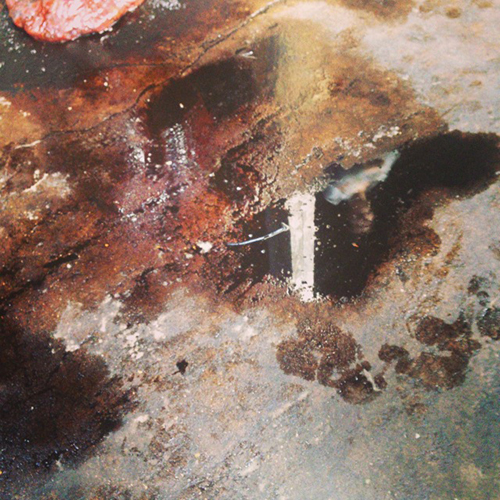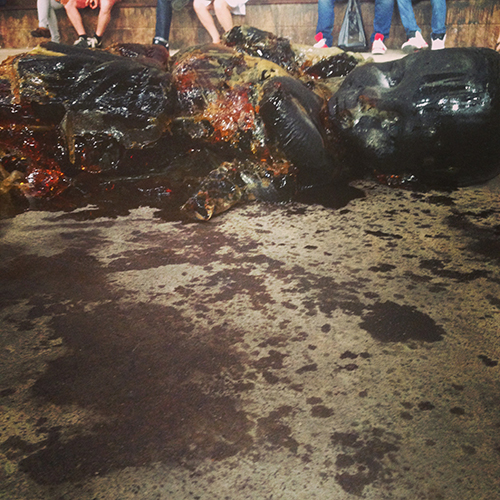
[Note: Each month we feature a guest post from a contributor to Poetry’s current issue. Rickey Laurentiis’s has four poems in the July/August 2014 issue. Previous posts in this series can be found on the Editors’ Blog.]
Now the lights of a long day start their slouch back home, which is the dark, and, like Kara Walker, my mind is thick with sugar. It’s been a few hours now since I’ve left the soon-to-be-demolished old Domino Sugar Factory just off the East River, and hours of aimless walking through Williamsburg has sufficiently beaten the stickiness from my shoes. At the factory sits in a kind of patient repose Walker’s first large-scale public project: a giant white, bandana-clad sugar Sphinx overlooking—what exactly? Who? She calls it subtle.
You will have read the reviews, the countless articles offering historical context (sugar production redefined our world, influenced the development of colonialism, was foundational to the Atlantic Slave Trade); you will have regarded the cautions about the long lines, the weather and even the audience, many of which do seem to take this project as yet another opportunity to—with smiles and laughter!—continue their objectification of the black and female body. But if you were like me, none of that would have exactly prepared you for the element itself, for the sugar.
I enter and I am met with that: the overwhelming smell of the sugar, pleasing at first until its excess, like what excess does, turns it sour. And beneath me each step is met with resistance. I take note of the smaller, molasses-black—could they have been made from molasses?—sugar boys. They’re scattered and carrying baskets and bundles, like little wise men bearing gifts to their Sphinx queen. Importantly, they’re melting, and everyone who’s witnessing them is in some way trampling and dragging bits of them by their soles throughout the factory.
The friend who’s with me wonders aloud if this is purposeful. He means the sticky floors, which grow stickier the nearer we get to the Sphinx. I don’t think so. I think instead the floors are just a result of the day’s traffic, a kind of certificate of all the many steps that have crossed this cement, and that are making my own steps that much harder to take. But I like this struggle. There is something sweet in it, and accurate. The whole time I stay obsessed with the floor, the walls, the pillars, the roof and smell—all paratext, form and dark residue. I hardly receive the “content” itself. I dismiss the Sphinx.
Another day I’m home, watching professor Mark Anthony Neal interview the poet and academic Elizabeth Alexander. The two are discussing Black poetry or, rather, the ways in which Black poetry has been and, perhaps, still is critically evaluated. “I’m still struck that in reviews,” Alexander begins, “Very little time is spent talking about how the poems are made, what shapes they come in, what strategies they have.” She’s using her hands here to emphasize her point: flailing them, shaping them into a kind of cup, twisting them as if she were working clay.
“Rather,” Alexander continues, “The reviews are about sort of the story of this poem and the black people in it.” Her hands, if briefly, fall to her lap.
Now the lights of a long day start their slouch back home, which is the dark, and, like Dorothea Lasky, I’m thinking in color. This month’s issue of Poetry comes with her careful investigation of the significance of color in poetry, and in it Lasky introduces me to “Very Strong February,” a poem by Bernadette Mayer. I’m intrigued by Lasky’s reading of the poem: how she argues that the poem uses color to make a kind of “imaginative testimony,” how color works as bridge even, connecting our human world to farther-off worlds of dreams and the dead, and, perhaps most importantly, connecting the reader to the emotional and intellectual landscape of the poem. She persuades me that a line like “A week or two left on distracting black trees” would lose its imaginative interest, its allure even, without that modifier “black,” which becomes evidence of the poet’s unique sensibilities and the way she orders the world. But I’m left to consider for myself what exactly “black” signifies—what in fact any of these colors exactly mean—in and outside the world of the poem, presently and historically, emotionally, discursively.
And I’m left to consider on my own the company of those “four dark men and a burnt sienna woman,” whose presence literally inspires the only break in the poetic text. There are other folks, of course, who crowd this poem: those who pretend to be “white ice,” who meet at the “lavender door” or refuse a “big pink kiss,” but curiously my mind obsesses on the apparent darknesses that these four men represent, on the burnt siennaness of this woman, all of whom exist ephemerally—for “for three minutes, then bye-bye like a gold watch,” we are told. The singular stanza break keeps begging my attention, practically screaming at me, and my mind returns to the sugar boys, to the Sphinx. What lives in these kinds of dark, I wonder, this burntness?
Because when I hear the word “color” I can’t help but to also hear “colored,” I confess I’m thinking about race. How does a discussion about this poem that has, arguably, “black people in it” get away without talking about those black people explicitly, primarily? That’s to ask, how does this discussion focus on strategy and form, over this “dark” content, and is such a privileging useful? I wonder if the focus has something to do with the color of the poet herself, or the essayist. I wonder if to ask that question matters. Maybe it’s best to stick with color itself, to begin thinking about and engaging with race in poems as we would any other color: not as a sort of fixed marker, inviting only one kind of analysis based mainly in history and sociology, not as evidence of a “story.” But maybe race too (like gender, like sexuality) can produce its own “imaginative testimony,” can be its own bridge between reader and the emotional and intellectual argument of the poem—and what then? When we recognize race as content and strategy.

Today I’m at the old Domino factory again, and the smell seems worse. The floors, though, are significantly less sticky, suggesting they’ve been cleaned, though I know they won’t stay that way much longer. For the sugar boys look even more distressed now: decrepit, gothic even, not just melting terribly, but melted, their syrupy innards spilling, bleeding, their limbs fallen to the floor, and one is completely knocked over, staring at me with large unblinking eyes.
All I can say is that I receive them more this time, as I will the Sphinx. I mean, my eye takes in their weight wholly, viscerally, like the shore takes in the full assault of the sea, and I do this even as I realize that they, like the shore, are each disappearing slowly by the minute. The floors and walls still interest me but, having considered them, I can now consider more fully what they contain.
I don’t know about you, but I try to build my poems like this: from the outside scaffolds, into the center. Even when I write my poems that concern race, race comes only by way of the particular strategies I have been—because poetry should be fun—playing with, and strategies which seem to lend themselves somehow best to a mediation on race, on desire, obsession, panic, fear.
Frequently, crucially, there is some aspect of collapse or deficiency in my game, a place where I get stuck, and I try to lean on that failure, exploit it, approve it. For I used to think of writing as a task where I wait, in darkness, for the words—the content—to rise steadily into the light. But life has taught me that the rocky dark is all we have. Poems, for me, are just machines for rearranging that darkness. And the darkness, I’ve realized, is as brutal as sugar.
Rickey Laurentiis grew up in New Orleans and earned an MFA from Washington University in St. Louis. ...
Read Full Biography

